Ferromagnetism & Antiferromagnetism | Basic Physics for IIT JAM PDF Download
Ferromagnetism
When you think of magnetic materials, you probably think of iron, nickel or magnetite. Unlike paramagnetic materials, the atomic moments in these materials exhibit very strong interactions. These interactions are produced by electronic exchange forces and result in a parallel or antiparallel alignment of atomic moments. Exchange forces are very large, equivalent to a field on the order of 1000 Tesla, or approximately a 100 million times the strength of the earth's field.
The exchange force is a quantum mechanical phenomenon due to the relative orientation of the spins of two electron.
Ferromagnetic materials exhibit parallel alignment of moments resulting in large net magnetization even in the absence of a magnetic field.
When you think of magnetic materials, you probably think of iron, nickel or magnetite. Unlike paramagnetic materials, the atomic moments in these materials exhibit very strong interactions. These interactions are produced by electronic exchange forces and result in a parallel or antiparallel alignment of atomic moments. Exchange forces are very large, equivalent to a field on the order of 1000 Tesla, or approximately a 100 million times the strength of the earth's field.
The exchange force is a quantum mechanical phenomenon due to the relative orientation of the spins of two electron.
Ferromagnetic materials exhibit parallel alignment of moments resulting in large net magnetization even in the absence of a magnetic field.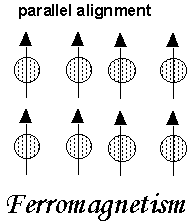
The elements Fe, Ni, and Co and many of their alloys are typical ferromagnetic materials.
Two distinct characteristics of ferromagnetic materials are their
(1) spontaneous magnetization and the existence of
(2) magnetic ordering temperature
Spontaneous Magnetization
The spontaneous magnetization is the net magnetization that exists inside a uniformly magnetized microscopic volume in the absence of a field. The magnitude of this magnetization, at 0 K, is dependent on the spin magnetic moments of electrons.
A related term is the saturation magnetization which we can measure in the laboratory. The saturation magnetization is the maximum induced magnetic moment that can be obtained in a magnetic field (Hsat); beyond this field no further increase in magnetization occurs.
The difference between spontaneous magnetization and the saturation magnetization has to do with magnetic domains (more about domains later). Saturation magnetization is an intrinsic property, independent of particle size but dependent on temperature.
There is a big difference between paramagnetic and ferromagnetic susceptibility. As compared to paramagnetic materials, the magnetization in ferromagnetic materials is saturated in moderate magnetic fields and at high (room-temperature) temperatures:

Curie Temperature
Even though electronic exchange forces in ferromagnets are very large, thermal energy eventually overcomes the exchange and produces a randomizing effect. This occurs at a particular temperature called the Curie temperature (TC). Below the Curie temperature, the ferromagnet is ordered and above it, disordered. The saturation magnetization goes to zero at the Curie temperature. A typical plot of magnetization vs temperature for magnetite is shown below.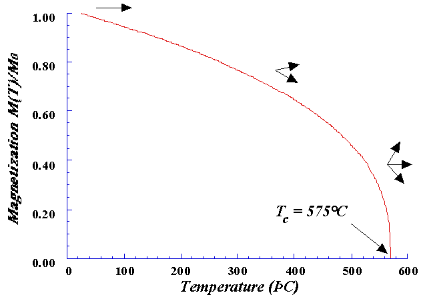
The Curie temperature is also an intrinsic property and is a diagnostic parameter that can be used for mineral identification. However, it is not foolproof because different magnetic minerals, in principle, can have the same Curie temperature.
Hysteresis
In addition to the Curie temperature and saturation magnetization, ferromagnets can retain a memory of an applied field once it is removed. This behavior is called hysteresis and a plot of the variation of magnetization with magnetic field is called a hysteresis loop.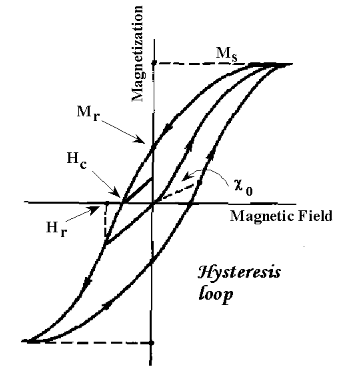
Another hysteresis property is the coercivity of remanence (Hr). This is the reverse field which, when applied and then removed, reduces the saturation remanence to zero. It is always larger than the coercive force.
The initial susceptibility (χ0) is the magnetization observed in low fields, on the order of the earth's field (50-100 μT).
The various hysteresis parameters are not solely intrinsic properties but are dependent on grain size, domain state, stresses, and temperature. Because hysteresis parameters are dependent on grain size, they are useful for magnetic grain sizing of natural samples.
Antiferromagnetism
If the A and B sublattice moments are exactly equal but opposite, the net moment is zero. This type of magnetic ordering is called antiferromagnetism.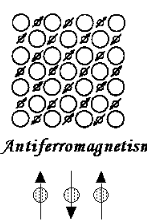
The clue to antiferromagnetism is the behavior of susceptibility above a critical temperature, called the Néel temperature (TN). Above TN, the susceptibility obeys the Curie-Weiss law for paramagnets but with a negative intercept indicating negative exchange interactions.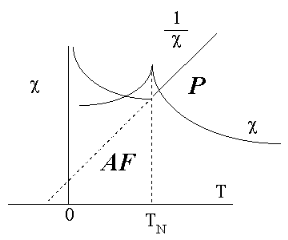
Crystal Structure of Hematite
Hematite crystallizes in the corundum structure with oxygen ions in an hexagonal close packed framework. The magnetic moments of the Fe3+ ions are ferromagnetically coupled within specific c-planes, but antiferromagnetically coupled between the planes.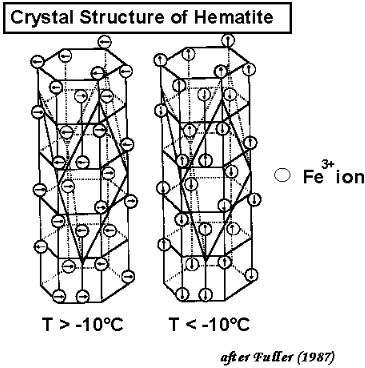
Above -10°C, the spin moments lie in the c-plan but are slightly canted. This produces a weak spontaneous magnetization within the c-plan (σs = 0.4 Am2/kg).
Below -10°C, the direction of the antiferromagnetism changes and becomes parallel to the c-axis; there is no spin canting and hematite becomes a perfect antiferromagnet.
This spin-flop transition is called the Morin transition.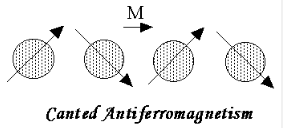
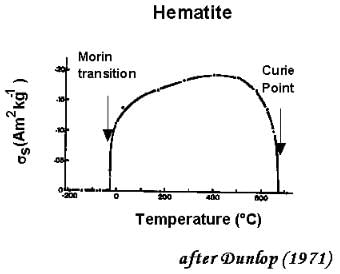
Magnetic Properties of Minerals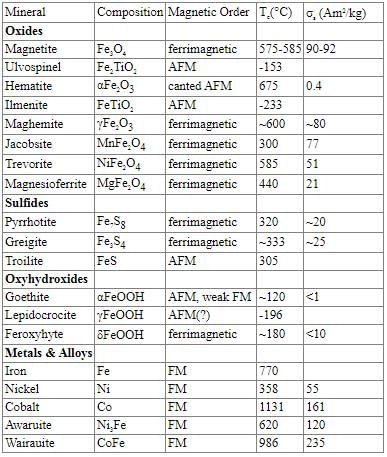
FM = ferromagnetic order
AFM = antiferromagnetic order
Tc = Curie or Néel Temperature
σs = saturation magnetization at room-temperature
Diamagnetism
Diamagnetism is a fundamental property of all matter, although it is usually very weak. It is due to the non-cooperative behavior of orbiting electrons when exposed to an applied magnetic field. Diamagnetic substances are composed of atoms which have no net magnetic moments (ie., all the orbital shells are filled and there are no unpaired electrons). However, when exposed to a field, a negative magnetization is produced and thus the susceptibility is negative. If we plot M vs H, we see: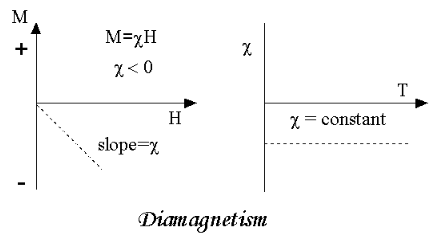
Note that when the field is zero the magnetization is zero. The other characteristic behavior of diamagnetic materials is that the susceptibility is temperature independent. Some well known diamagnetic substances, in units of 10-8 m3/kg, include:
quartz (SiO2) -0.62
Calcite (CaCO3) -0.48
water -0.90
Paramagnetism
This class of materials, some of the atoms or ions in the material have a net magnetic moment due to unpaired electrons in partially filled orbitals. One of the most important atoms with unpaired electrons is iron. However, the individual magnetic moments do not interact magnetically, and like diamagnetism, the magnetization is zero when the field is removed. In the presence of a field, there is now a partial alignment of the atomic magnetic moments in the direction of the field, resulting in a net positive magnetization and positive susceptibility.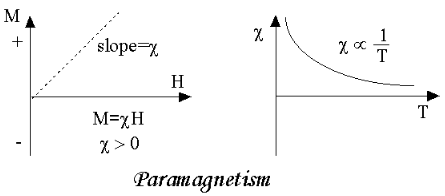
In addition, the efficiency of the field in aligning the moments is opposed by the randomizing effects of temperature. This results in a temperature dependent susceptibility, known as the Curie Law.
At normal temperatures and in moderate fields, the paramagnetic susceptibility is small (but larger than the diamagnetic contribution). Unless the temperature is very low (<<100 K) or the field is very high paramagnetic susceptibility is independent of the applied field. Under these conditions, paramagnetic susceptibility is proportional to the total iron content. Many iron bearing minerals are paramagnetic at room temperature. Some examples, in units of 10-8 m3/kg, include:
Montmorillonite (clay) 13
Nontronite (Fe-rich clay) 65
Biotite (silicate) 79
Siderite(carbonate) 100
Pyrite (sulfide) 30
The paramagnetism of the matrix minerals in natural samples can be significant if the concentration of magnetite is very small. In this case, a paramagnetic correction may be needed.
Ferrimagnetism
In ionic compounds, such as oxides, more complex forms of magnetic ordering can occur as a result of the crystal structure. One type of magnetic ordering is call ferrimagnetism. A simple representation of the magnetic spins in a ferrimagnetic oxide is shown here.
The magnetic structure is composed of two magnetic sublattices (called A and B) separated by oxygens. The exchange interactions are mediated by the oxygen anions. When this happens, the interactions are called indirect or superexchange interactions. The strongest superexchange interactions result in an antiparallel alignment of spins between the A and B sublattice.
In ferrimagnets, the magnetic moments of the A and B sublattices are not equal and result in a net magnetic moment. Ferrimagnetism is therefore similar to ferromagnetism. It exhibits all the hallmarks of ferromagnetic behavior- spontaneous magnetization, Curie temperatures, hysteresis, and remanence. However, ferro- and ferrimagnets have very different magnetic ordering.
Magnetite is a well known ferrimagnetic material. Indeed, magnetite was considered a ferromagnet until Néel in the 1940's, provided the theoretical framework for understanding ferrimagnetism.
Crystal Structure of Magnetite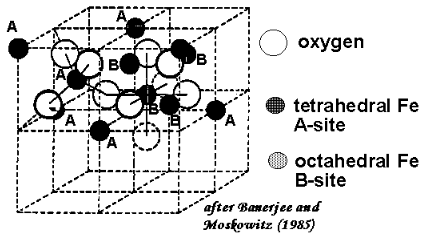
Magnetite, Fe3O4 crystallizes with the spinel structure. The large oxygen ions are close packed in a cubic arrangement and the smaller Fe ions fill in the gaps. The gaps come in two flavors:
tetrahedral site: Fe ion is surrounded by four oxygens
octahedral site: Fe ion is surrounded by six oxygens
The tetrahedral and octahedral sites form the two magnetic sublattices, A and B respectively. The spins on the A sublattice are antiparallel to those on the B sublattice. The two crystal sites are very different and result in complex forms of exchange interactions of the iron ions between and within the two types of sites.
The structural formula for magnetite is
[Fe3+]A [Fe3+,Fe2+]B O4
This particular arrangement of cations on the A and B sublattice is called an inverse spinel structure. With negative AB exchange interactions, the net magnetic moment of magnetite is due to the B-site Fe2+.
|
210 videos|156 docs|94 tests
|
FAQs on Ferromagnetism & Antiferromagnetism - Basic Physics for IIT JAM
| 1. What is ferromagnetism? |  |
| 2. How does ferromagnetism differ from paramagnetism? |  |
| 3. What is antiferromagnetism? |  |
| 4. How does antiferromagnetism differ from ferromagnetism? |  |
| 5. Can antiferromagnetic materials be used in practical applications? |  |

|
Explore Courses for Physics exam
|

|












